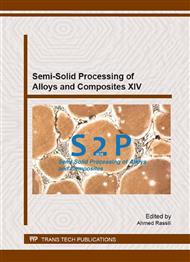p.237
p.243
p.251
p.257
p.263
p.270
p.276
p.282
p.288
Rheo-Forming AZ91D Magnesium Alloy Using Enthalpy Equilibrium Electromagnetic-Stirring Process
Abstract:
An enthalpy equilibrium electromagnetic-stirring process was introduced to semisolid metal processing for rheoforming route. AZ91D was die-casted under normally liquid state of Mg alloy, semisolid state of Mg alloy stirred using traditional EM-stirrer and an enthalpy equilibrium EM-Stirrer, respectively. Further step, effect of pouring temperature on microstructures and tensile properties of castings was researched in the introduced process. Experimental results indicated that samples of rheo-diecasted in the introduced process showed globular primary solid particle microstructure and better comprehensive mechanical properties, typical microstructures consisting of globular primary α-Mg grains and pseudoeutectic organization was observed in the castings with low solid fraction, while in higher solid fraction, the microstructure comprised of agglomerating primary solid particles and Mg17Al12 of divorced eutectic. With decreasing pouring temperature, the density of primary solid particles increased greatly, the size of primary solid particle evolved to coarse.
Info:
Periodical:
Pages:
263-269
Citation:
Online since:
September 2016
Authors:
Keywords:
Price:
Сopyright:
© 2016 Trans Tech Publications Ltd. All Rights Reserved
Share:
Citation:


